
Dubrovnik, historically known as Ragusa, is a city in southern Dalmatia, Croatia, by the Adriatic Sea. It is one of the most prominent tourist destinations in the Mediterranean, a seaport and the centre of the Dubrovnik-Neretva County. Its total population is 41,562. In 1979, the city of Dubrovnik was added to the UNESCO list of World Heritage Sites in recognition of its outstanding medieval architecture and fortified old town.
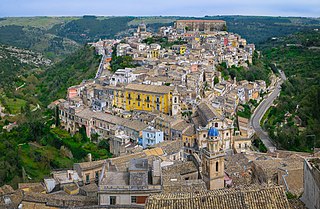
Ragusa is a city and comune in southern Italy. It is the capital of the province of Ragusa, on the island of Sicily, with 73,288 inhabitants in 2016. It is built on a wide limestone hill between two deep valleys, Cava San Leonardo and Cava Santa Domenica. Together with seven other cities in the Val di Noto, it is part of a UNESCO World Heritage Site.

French Baroque architecture, usually called French classicism, was a style of architecture during the reigns of Louis XIII (1610–1643), Louis XIV (1643–1715) and Louis XV (1715–1774). It was preceded by French Renaissance architecture and Mannerism and was followed in the second half of the 18th century by French Neoclassical architecture. The style was originally inspired by the Italian Baroque architecture style, but, particularly under Louis XIV, it gave greater emphasis to regularity, the colossal order of façades, and the use of colonnades and cupolas, to symbolize the power and grandeur of the King. Notable examples of the style include the Grand Trianon of the Palace of Versailles, and the dome of Les Invalides in Paris. In the final years of Louis XIV and the reign of Louis XV, the colossal orders gradually disappeared, the style became lighter and saw the introduction of wrought iron decoration in rocaille designs. The period also saw the introduction of monumental urban squares in Paris and other cities, notably Place Vendôme and the Place de la Concorde. The style profoundly influenced 18th-century secular architecture throughout Europe; the Palace of Versailles and the French formal garden were copied by other courts all over Europe.

Mantua Cathedral in Mantua, Lombardy, northern Italy, is a Roman Catholic cathedral dedicated to Saint Peter. It is the seat of the Bishop of Mantua.

The Assumption Cathedral is a Roman Catholic cathedral in Dubrovnik, Croatia. It is the seat of the Diocese of Dubrovnik.
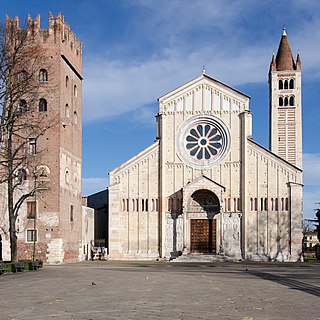
The Basilica di San Zeno is a minor basilica of Verona, northern Italy constructed between 967 and 1398 AD. Its fame rests partly on its Romanesque architecture and partly upon the tradition that its crypt was the place of the marriage of Shakespeare's Romeo and Juliet.

San Cristoforo sul Naviglio is a church in Milan, northern Italy.

Ljubljana Cathedral, officially named Saint Nicholas's Church, also named Saint Nicholas's Cathedral, the Cathedral of Saint Nicholas, or simply the Cathedral, is a cathedral in Ljubljana, the capital of Slovenia. Originally, Ljubljana Cathedral was a Gothic church. In the early 18th century, it was replaced by a Baroque building. It is an easily recognizable landmark of the city with its green dome and twin towers and stands at Cyril and Methodius Square by the nearby Ljubljana Central Market and Town Hall.

The Metropolitan Cathedral of Saint Agatha, usually known as the Catania Cathedral, is a Roman Catholic cathedral in Catania, Sicily, southern Italy. It was the seat of the Bishops of Catania until 1859, when the diocese was elevated to an archdiocese, and since then has been the seat of the Archbishops of Catania.

Stradun or Placa, whose name derives from Venetian, and means "large road" or "wide road", is the main street of Dubrovnik, Croatia. The limestone-paved pedestrian street runs some 300 metres through the Old Town, the historic part of the city surrounded by the Walls of Dubrovnik.

Teramo Cathedral is a Roman Catholic cathedral in Teramo, Abruzzo, central Italy, dedicated to the Assumption of the Virgin Mary and to Saint Berardo, patron saint of the city. It is the seat of the Bishop of Teramo-Atri. Built in Romanesque-Gothic style, it was consecrated in 1176.

The Church of San Marco in San Girolamo is a baroque parish church in Vicenza, northern Italy, built in the 18th century by the Discalced Carmelites. It houses various artworks by artists of the early 18th century from Veneto. The sacristy preserves its original furniture of the same period.

The Metropolitan Cathedral and Parish of Saint John the Evangelist, also known as the Naga Metropolitan Cathedral, is a Roman Catholic cathedral in Naga, Camarines Sur, Philippines. It is the seat of the Archdiocese of Caceres. The first church was established after the creation of the archdiocese as the Diocese of Nueva Cáceres in 1595. The present cathedral was built in 1808, and was completed and consecrated in 1843.
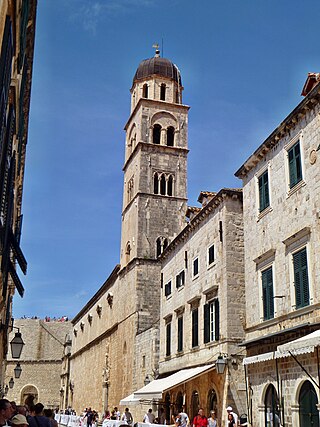
The Franciscan friary and church is a large complex belonging to the Order of the Friars Minor. It consists of a friary, a church, a library, and a pharmacy. It is situated at the Placa, the main street of Dubrovnik, Croatia.

Santa Caterina d'Alessandria or Saint Catherine of Alexandria is a Roman Catholic church with a main facade on Piazza Bellini, and a lateral Western facade facing the elaborate Fontana Pretoria, in the historic quarter of Kalsa in the city of Palermo, region of Sicily, Italy. In front of the main facade, across the piazza Bellini, rise the older churches of San Cataldo and Santa Maria dell'Ammiraglio, while across Piazza Pretoria is the Theatine church of San Giuseppe and the entrance to the Quattro Canti. Refurbished over the centuries, the church retains elements and decorations from the Renaissance, Baroque, and late-Baroque (Rococo) eras. This church is distinct from the Oratorio di Santa Caterina found in the Olivella neighborhood.
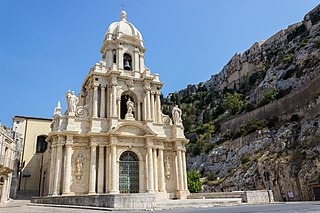
San Bartolomeo is a late Baroque-style, Roman Catholic church in the town of Scicli, province of Ragusa, Sicily, Italy.

San Giuseppe is a Baroque-style, Roman Catholic church located in the city of Ragusa, in southern Sicily, Italy.

The St. Catherine of Alexandria Church is a Roman Catholic church in the Tabán quarter of Budapest, Hungary. It is the parish church of the Tabán Parish which also comprises parts of Gellért Hill and Naphegy. The church is a listed monument that was built in Central European Baroque style between 1728 and 1777. It was reconstructed several times in the 19th–20th centuries.

The Collegium Ragusinum, sometimes also Rhagusinum, was the Jesuit college in the Republic of Ragusa, now the city of Dubrovnik in Croatia. Following early Jesuit presence in Ragusa in the late 1550s, the college was established in 1658 and closed in 1773 with the suppression of the Society of Jesus. Its preserved church is dedicated to Saint Ignatius, and the other buildings now host a Catholic gymnasium and other Church facilities. The complex has been referred to as "considered to be the finest Baroque set of buildings in Dubrovnik, and - according to many - in all of Dalmatia."
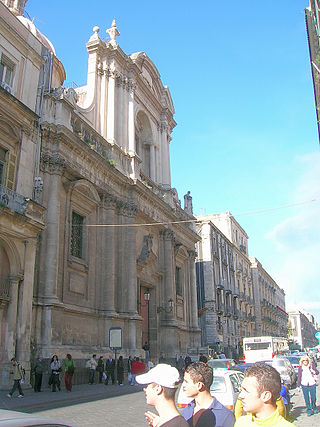
San Michele Arcangelo ai Minoriti is a Roman Catholic parish church and attached monastery in the city center of Catania, region of Sicily, Italy. The former monastery, to the left of the facade, now houses shops on the ground-floor, and above are the offices of the Provincial government and the Prefettura or Prefecture.




















